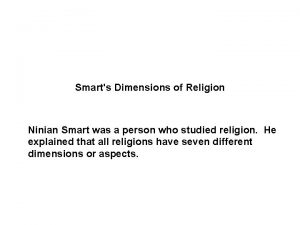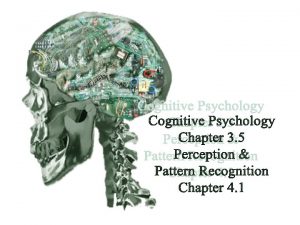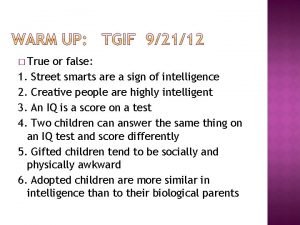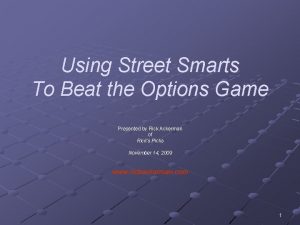Street Smarts Visual Attention on the Go Alexander














- Slides: 14

Street Smarts: Visual Attention on the Go Alexander Patrikalakis May 13, 2009 6. XXX

Vision of Attention • For machines to recreate human visual attention, we must accept that humans: – Maintain multi-scale orientation, intensity, and color feature neuronal maps in parallel – Combine multi-scale features into a central conspicuity (saliency) map – Maintain a Winner-Take-All neural network that saccades to and subsequently inhibits decreasingly salient points

Example Object recognition at all points of an image is infeasible time-wise Visual attention allows us to find the interesting points quickly Ullman agrees: “Recognition over the whole scene leads to a combinatorial explosion. ”

Implementation Steps • Analyzed previous work done by Ullman, Itti, and Koch on visual attention • Implemented visual saliency model in C++ using Intel Open. CV, IPP, and TBB • Implemented FOA shifting by saccading to points with decreasing saliency map values; same effect as a 2 D neuronal matrix

Results • Tested algorithm on 13 geometric scenes, and obtained plausible salient winners in each • Tested algorithm on 40 natural scenes (roads and highways) and found that signs and signals are very salient (usually saccaded to first) • Algorithm resilient to noise and takes advantage of multi-scale analysis

Itti: Normalization • Promote maps with small numbers of strong maxima • Suppress maps with large numbers of equally strong maxima • Method: scales maps by the difference between global maximum and mean of remaining maxima

Ullman, Itti, Koch: Multi-scale features Multi-scale Architecture Three Feature Maps

Ullman: The Winner-Takes-All (WTA)

Simple Example

Noise Resilience

Multi-scale Advantage 1

Multi-scale Advantage 2

Problematic distractions

Contributions • Reviewed past work done on biologically inspired visual attention models • Identified Itti’s algorithm as a candidate for saliency detection in natural scenes involving road signs • Demonstrated algorithm’s effectiveness on many natural scenes involving road signs • Created a prototype saliency heuristic for evaluating sign effectiveness
 Street knowledge vs book knowledge
Street knowledge vs book knowledge Michelle benjamin phd
Michelle benjamin phd Alpha smarts
Alpha smarts Ninian smarts model
Ninian smarts model Web smarts
Web smarts Emc smarts global console
Emc smarts global console Course smarts
Course smarts Lines of accounting dts
Lines of accounting dts Perbedaan pemrograman konvensional dan pemrograman visual
Perbedaan pemrograman konvensional dan pemrograman visual Sự nuôi và dạy con của hổ
Sự nuôi và dạy con của hổ Thiếu nhi thế giới liên hoan
Thiếu nhi thế giới liên hoan điện thế nghỉ
điện thế nghỉ Một số thể thơ truyền thống
Một số thể thơ truyền thống Biện pháp chống mỏi cơ
Biện pháp chống mỏi cơ Trời xanh đây là của chúng ta thể thơ
Trời xanh đây là của chúng ta thể thơ


























